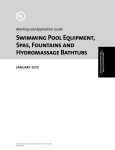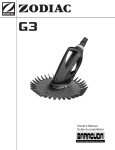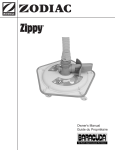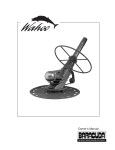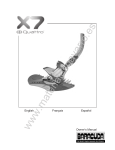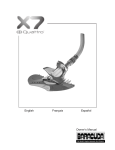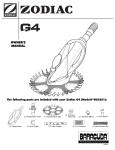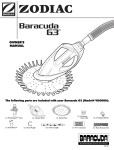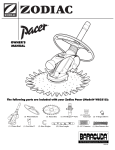Download Zodiac ZHP-3216-TI User`s manual
Transcript
ZHP-3216-TI ZHP-80-TI ZHP-65-TI TITANIUM SERIES HEAT PUMPS W235611 rev 2 2005/2006 USER’S MANUAL & INSTALLATION MANUAL FAILURE TO FOLLOW INSTRUCTIONS WILL VOID YOUR WARRANTY. MANDATORY SAFETY INSTRUCTIONS Congratulations on your purchase of a Zodiac Heat Pump! Your new heat pump from Zodiac will extend your swimming season and provide you years of pool comfort and pleasure. This manual will help you answer questions you may have, provide technical support, and allow you to safely enjoy your new Zodiac Heat Pump. Please take a few moments to read through the entire manual. IMPORTANT: YOUR HEAT PUMP MUST BE INSTALLED BY A QUALIFIED ELECTRICIAN READ AND FOLLOW ALL INSTRUCTIONS. ! WARNING Failure to heed the following warnings can result in permanent injury, electrocution or drowning. ELECTRICAL HAZARD • To reduce risk of electrical shock – All electrical connections must be performed by a qualified electrician as per all applicable national, provincial, state or local electrical codes. – Make sure all electric power is off to pool equipment area prior to any installation or removal of Zodiac components. – A clearly identified breaker must be installed in order to shut off electrical power to the heat pump in an emergency. – Never open the electrical box without shutting off all power sources to the heat pump. – If your heat pump features a water pump control option, do not forget to shut off the breaker to this water pump before servicing. CHEMICAL USE HAZARD • Improperly balanced water can grow bacteria and become a health concern, as well as damage your pool and its equipment. Please have your water tested by a pool professional weekly. • To avoid personal injury when working with pool chemicals, always wear rubber gloves and eye protection and work in a wellventilated area. Use caution when choosing a location to open and use chemicals as they may damage any surface in which they come in contact. EQUIPMENT WATER PRESSURE HAZARD • Your pump/filter system is operated under pressure and the pressure must be released before you begin work. Please see your pump/filter owner’s manual for further instructions. PREVENT CHILD INJURY AND DROWNING • To reduce the risk of injury, do not permit children to operate this product. • Do not let anyone, especially small children, sit, step, lean, or climb on any equipment installed as part of your pool’s operational system. Unless otherwise stated, ALL components of your pool's operational system should be located at least 3 feet from the pool so children cannot use the equipment to gain access and be injured or drown. ! CAUTION Failure to heed the following warnings could cause damage to pool equipment. • Thermodynamical and electrical characteristics are indicated on the number plate. • Voltage requirements for the ZHP-3216-TI, ZHP-80-TI and ZHP-65-TI heat pump are 220V – make sure you connect to a proper electrical source. • Make sure there are no sprinkler heads near or directed at the heat pump. Most sprinklers are connected to wells which contain minerals, sulphur and other aggressive contaminates in the water.These contaminates can cause corrosion and affect the heat pumps efficiency. • Do not place any chemicals directly into the skimmer. Doing so may cause damage to the heat exchanger. Chemicals should be poured slowly into the pool in front of the return inlet to be dispersed evenly throughout the pool. ! ! ELECTRICAL WARNINGS WARNING Prevent injury from electrical current. • Electrical installations must be performed by qualified electricians only. Installation made by unqualified persons can result in hazards to the installer and others. • The electrical installation must conform to the most current version of the National Electrical Code, NFPA No. 70, and all applicable local and state codes. SAVE ALL INSTRUCTIONS. 2 TABLE OF CONTENTS I Introduction ................................................p.4 A Cost-Efficient Heater How Does It Work? Low Maintenance II Selecting the Location ..............................p.5 Air Supply and Accessibility Other Recommendations III Water Inlet and Outlet Connections........p.6 Connections to Heat Pump Minimum/Maximum Water Flow Rates Basic Connection Chlorinators, Brominators and Other Automatic Systems Off-Line Chlorinator or Brominator Salt Chlorinator Multiple Unit Connection IV Maintenance..................................................p.8 Cleaning Winterizing (Titanium Heat Exchanger) Seasonal Start-up V Some Tips on Water Chemistry ............p.9-10 How to Adjust pH Total Alkalinity Affects pH Sanitizers VI Heat Pump Digital Control ..........p.11-12-13 VII Questions and Answers............................p.14 VIII Zodiac Pool Heat Pumps Exclusive Limited Warranty ................p.15-16 3 INTRODUCTION A Cost-efficient Heater Your new pool heat pump is the most cost efficient way to heat your pool.Traditional pool heating systems like natural gas, propane gas, oil and electric can only generate heated pool water on a dollar to dollar basis at best. In fact, the more expensive fuels like electricity and oil return 70¢ - 80¢ of heat for every dollar spent resulting in an inefficient operating return on investment. How Does It Work Heat pumps work much like an air conditioner works but only in reverse. The Zodiac heat pump has the unique ability to capture free warmth and moisture from the surrounding air and transfer it to your pool water. It is because of this principle that your pool heat pump may attain efficiency ratios going up to 600% or 700% in the best climactic conditions (COP 6 to 7). Just as “miles per gallon” is an important measure in evaluating the efficiency of an automobile, COP (Coefficiency of Performance) is the critical measure of efficiency for evaluating heat pumps.The higher the COP number, the more efficient the heat pump. Simply said, that means for every dollar spent on electricity to power the heat pump, you will get that dollar multiplied by the COP factor back in total dollars worth of pool heat. As an example, the Zodiac ZHP-3216-TI with one of the higher COP’s in the industry at 6.4 yields $6.40 worth of pool heat per $1.00 invested of electricity. $1.00 x 6.4 = $6.40. Illustration based on (2) paid for units of electric energy to operate heat pump. B C A 8 free units of heat from outside air at 77˚F Warm water to pool. Cool water from pool. Yields 10 total units of heat to pool. EVAPORATOR COMPRESSOR The fan draws warm, moist surrounding air into the evaporator. R-22 environmentally friendly liquid Freon is pumped through copper tubing within the evaporator. As the warm outside air passes through the evaporator the liquid Freon becomes a heated gas. As the heated Freon gas enters the compressor it is put under pressure which creates an even hotter gas. HEAT EXCHANGER The hot compressed gas is pumped through the heat exchange coil which transfers heat to the surrounding pool water. As water circulates through the heat exchanger it is heated 3 ˚ - 5 ˚ F and is returned to the pool.This cycle continues until the water reaches the desired set point temperature. LOW MAINTENANCE Your pool heat pump is designed for lower maintenance at a lower cost. But if you want your pool to be heated efficiently, you must follow the advice we supply in this manual. 4 SELECTING THE LOCATION The area you choose for your pool heat pump is very important. You must consider the following. Air Supply and Accessibility Your heat pump uses the surrounding air to work. It is very important that you make sure there is enough air circulation around the heat pump. Do not install the heat pump in a closed space like a garden shed, a garage or a basement. The table below indicates the minimum distance from the heat pump that any object should be located. (1) (2) (3) (4) facing facing facing facing the coil surfaces other surfaces fan* service panel ZHP-3216-TI, ZHP-80-TI & ZHP-65-TI 2 feet 14 inches 4 feet 2 feet * Objects should be placed as far as possible from where the air is discharged. 2 1 1 4 3 IMPORTANT: Your heat pump must have sufficient clearance to properly function! Other Recommendations Do not install the heat pump under the overhang of a roof where rain or snow will accumulate on the heat pump. Also, avoid having the digital control facing the sun.This will make the display difficult to read. The pool heat pump must be installed on a firm and leveled surface, preferably on a concrete slab or something equivalent. Keep in mind that the heat pump will cause condensation, therefore water will be dripping from the heat pump. Check local codes Check your local building and electrical codes concerning installation and location of your heat pump. 5 WATER INLET AND OUTLET CONNECTIONS CONNECTIONS TO HEAT PUMP Plumb the ZHP-3216-TI, ZHP-80-TI and ZHP-65-TI heat pump inlet and outlet with schedule 40, 1.5 inch PVC. MINIMUM/MAXIMUM WATER FLOW RATES Your heat pump is designed to operate successfully between flow rates of 20 to 70 gallons per minute (GPM). The plumbing system must be designed to maintain at least 20 GPM flow through the heat pump. At flow rates less than 20 GPM, the heat pump will not operate correctly and may become damaged. At flow rates above 70 GPM, the unit will operate less efficiently and may become damaged. A bypass valve (Fig. A) must be installed in order to isolate the heat pump. We recommend installing a flow meter between the bypass valve and the heat pump to determine the flow rate and properly adjust the position of the bypass valve to the ideal range. A spring-check bypass valve is required when a pool pump of 2 HP or larger is used (for bypass valve placement detail, see plumbing schematic below). ! CAUTION Failure to establish proper water flow rates may result in damage to the heat pump and void the warranty. Many flow meters require a long distance of straight tubing on the inlet side to offer an adequate measurement. MODEL ZHP-3216-TI ZHP-80-TI ZHP-65-TI MINIMUM 30 GPM 30 GPM 20 GPM IDEAL 35 GPM 35 GPM 35 GPM MAXIMUM 70 GPM 70 GPM 70 GPM Front View ZHP-3216-TI ZHP-80-TI ZHP-65-Ti Top View Bypass valve Water Outlet Water Inlet Flow meter Fig. A Bypass valve WARNING WINTERIZING HEAT EXCHANGER DO NOT OVERTIGHTEN CONNECTIONS GENERAL RECOMMANDATIONS (CHECK OWNER’S MANUAL) DO NOT APPLY PRESSURE ON CONNECTIONS AND TUBING - TURN OFF THE UNIT - SHUT OFF THE BREAKER ON THE HEAT PUMP - UNCONNECT THE WATER INLET AND OUTLET CONNECTIONS - IF THE HEAT PUMP IS LEFT OUTSIDE DURING WINTER, PROTECT IT WITH A WATER PROOF COVER OUTLET INLET ! CAUTION Zodiac heat pumps are designed to work at a normal operating pressure of 20 PSI (1.4 bars). Maximum pressure is 30 PSI (2 bars). Heat pump installation must be designed to insure that the maximum operating pressure is not exceeded; otherwise the warranty will be void. 6 Basic Connection Chlorinator ZHP-3216-TI ZHP-80-TI ZHP-65-TI Top View Flow Meter Filter Pool Pool Pump The heat pump installs after the pool pump and filter, but before any chlorinator or chemical feeder. To avoid chemical damage to the heat pump, do not pour chemicals directly into the skimmer or main drain. Refer to the maintenance section of this manual for additional information. Chlorinators, Brominators and Other Automatic Systems IMPORTANT: Any automatic distribution system of chemical products, chlorine, bromine or others, must be installed after the outlet of water from the heat pump.Your heat pump can be damaged, and your warranty voided, if you install an automatic chemical distribution system before the outlet from the heat pump. The use of a brominator or a chlorinator tends to lower pH and total alkalinity because of the chemicals in it. If you use such a product, you must check the quality of the water regularly. (Addition of sodium bicarbonate is recommended to restore the balance.) (See the section Water Chemistry on p. 9.) Off-Line Chlorinator or Brominator Check Valve ZHP-3216-TI ZHP-80-TI ZHP-65-TI Top View Pool Filter Pool Pump Flow Meter The off-line chlorinator or brominator takes a small amount of water from the inlet side of the filter, adds chemicals to it and returns this highly concentrated solution to the pool. The check valve must be highly resistant to corrosion. Use only a check valve either supplied or recommended by the chlorinator (brominator) manufacturer. Chlorinator Salt Chlorinator Salt chlorinators, like in-line chlorinators, must be installed as the last component on the pool return line (the heat pump must be installed before the chlorinator or the warranty will be void). Salt levels used with salt chlorinators will not harm titanium heat exchanges. Whenever using a salt chlorinator, we recommend the use of a check valve so chemicals do not backup into the heat pump. Multiple Unit Connection Multiple installations can be used in parallel or in series.We recommend series installation for a quicker temp rise. For some larger pools, it may be necessary to install two units in parallel. In multiple installations, double the distances recommended in the table on page 5. Never place two heat pump models coil against coil, fan against fan or coil against fan as the heat pumps cannot work properly. Such an installation voids your warranty. 7 MAINTENANCE ! WARNING Before performing any maintenance on the heat pump you must turn off the electricity at the breaker of the electrical supply line. Cleaning To ensure optimum performance of the heat pump, follow these recommendations: • Backwash the filter of the pool on a regular basis in order to ensure proper flow rate through the pool heater. • Keep the surfaces of the coil clean and free of any obstruction such as papers, leaves or other debris. • Carefully clean the unit using a soft, non abrasive and bleach free cleaner, and rinse using a garden hose without the nozzle. • Check the drainage holes of the base of the unit to make sure that they are clean and unobstructed. (This prevents water from accumulating in the heat pump.) Winterizing (Titanium Heat Exchanger) If you close the swimming pool during the winter season, it is essential to drain the unit in order to prevent the formation of ice in the condenser (water section). To winterize the heat pump, you must : 1. Turn off the unit. 2. Shut off the breaker of the heat pump electrical supply line. 3. Disconnect the water inlet and outlet connections (Figure A). 4. Freely flush the condenser. 5. If the heat pump is left outside during winter, protect it with a waterproof cover. Loosen bypass valves B. A. Seasonal Start-up Before starting the pool heat pump for the first time of the season, you must: 1. Make sure that the electrical breaker of the pool heat pump is in the off position. 2. Flush with tap water until clean. 3. Replumb the heat pump and close by-pass valve (to avoid high concentration of water from entering the heat pump). 4. Clean the pool filter and make sure the water is flowing adequately through to pool return line. 5. Chemically balance and clean pool water. 6. Switch on the breaker of the heat pump electrical supply line. 7. Open bypass valve. 8 SOME TIPS ON WATER CHEMISTRY Your heat pump, just as any type of pool heater (gas, oil, electric, etc.), features some metal parts that can be damaged by bad pool water chemistry. The condenser of your pool heat pump is made of a copper alloy that, as resistant as it is, is sensitive to pH. That is why we strongly recommend testing the quality of the pool water regularly. These tests must be made on at least a weekly basis and must at least feature the following: chlorine or bromine, pH and total alkalinity (TA). We suggest having the pool water tested by a professional (often free of charge) once a month. The water of the pool or spa must be maintained within the standards included in this manual. Failure to maintain proper water balance will void your pool heater warranty. Chemical Products Concentration in Pool Water Standard pH Total alkalinity Total hardness Free chlorine Chlorine stabilizer (Cyanuric acid) 7.2 to 7.6 80 to 120 ppm 200 to 400 ppm 1 to 3 ppm 40 to 100 ppm depending on regional climate IMPORTANT: Several components (e.g., pH, total alkalinity, calcium hardness, temperature) influence water balance, typically measured against a standard Saturation Index (SI).Although each component has its own individual recommended range, the individual components are weighted and combined in a mathematical function to determine whether the water is properly balanced (SI range: +0.3 to -0.3).As a result, even if major components are within the recommended individual ranges, but at the extreme high end of those ranges, the water may not be balanced and problems may occur. Example: If your pH and total alkalinity are both at the high end of their recommended ranges, scaling may occur. This is one of the reasons why you should have your water checked by a trained professional periodically. The most important factor for the durability of the pool heat pump is the pH because the capability of the water to cause the degradation of metal is directly related to it. Total alkalinity is the measure of the capacity of water to resist pH variation; therefore it is also very important. How to Adjust pH A pH range of 7.2 - 7.6 is ideal for maximum comfort and minimum chlorine demand. Always adjust total alkalinity before adjusting pH. Low pH (acidic water) leads to stinging eyes and corrosion of open metal fittings. Raise the pH by adding sodium bicarbonate or soda ash. Consult your pool professional regarding which chemical is best for your situation and the proper amount to use. Check the pH after 4 hours of circulation, adjusting as necessary to achieve the proper range. High pH (alkaline water) leads to clouding of the water, scaling and reduces the amount of active chlorine. This means algae and germs can grow. Lower the pH by adding muriatic acid to the pool water. The acid demand indicated by your 4-in-1 test kit will show the amount of acid to use. If your pH remains inconsistent, check your total alkalinity. Total Alkalinity Affects pH Total alkalinity is a measure of the alkaline chemicals in your pool water (eg. Bicarbonates, carbonates, and hydroxides). It can be thought of as the buffering system necessary to control pH. Low alkalinity can be compared to weak shock absorbers on a car, allowing pH to fluctuate.The pH will be difficult to maintain and staining of pool surfaces may occur when total alkalinity is too low. Total alkalinity should be in the range of 80 - 120 ppm.Total alkalinity is often confused with pH, which it affects. To raise total alkalinity, add pH buffer (sodium bicarbonate) at the rate shown in the manufacturers instructions to achieve a reading in the 80 - 120 ppm range. 1.5 lbs. of sodium bicarbonate raises 10,000 gallons of pool water by 10 ppm. To lower the total alkalinity, use muriatic acid. The acid demand chart in your 4-in-1 test kit will indicate the necessary amount to add. Adjust as needed until the reading (taken at least 24 hours later) is in the 80-120 ppm range. Once the total alkalinity is correct, you may need to adjust pH. 9 Sanitizers Sanitizers are products used to sanitize water, to relieve it from microbes and algae.They are chlorine, in its different forms and bromine. Each has its advantages and inconveniences and have different pH values. They can have different impacts on water chemistry and can necessitate various chemical products to counter-balance those impacts or to stabilize them. Warm water is more difficult to maintain, it necessitates greater quantities of sanitizers, and therefore, greater quantities of other chemical products. ! CAUTION Never pour any sanitizer directly into the skimmer. High concentrations may enter the heat pump, damage it, and void the warranty ! CAUTION Shock Treatment - Before performing any shock treatment, turn bypass off to stop water flow through the pool heat pump to prevent chemical products from damaging it. • Trichloro-s-triazinetrione (TCCA or trichlor or pucks) Trichlor is a very common and practical sanitizer because it dissolves into hypochlorous acid, a powerful sanitizer, and into cyanuric acid, a stabilizer improving the duration of its efficiency. However, it produces 2 acids that contribute to lowering pH and TA of the pool water. This can cause severe damage to the pool and to its system because of corrosion. Usage of trichlor requires the addition of sodium bicarbonate to raise the pH and TA level. WARNING: Many users testing only pH will be tempted to use sodium carbonate, or pH+, however this product does not increase TA level and pH will rapidly decrease after its use. As acidic water is usually clear because it is free of microorganisms, it is recommended that you test water regularly to avoid problems caused by acid water. Clear water is not the same as good quality water. ! • CAUTION With trichlor, it is possible to use what is called a chlorinator.A chlorinator is an automatic chlorine distribution system, but this system does not control pH and TA of water. Thinking their system is completely automatic, users of those systems often neglect to test their water. Always test your water! Bromine Bromine is a very good sanitizer. It is safe and practical. It does not require any stabilizer and it does not cause irritation nor has any odor. Furthermore, its efficiency is independent from pH of water. However, it is acid and it destroys TA. Water that is acid and low in TA becomes corrosive and disintegrates metallic pieces of the pool system, including the heat exchanger of your pool heat pump. Therefore, it is imperative to test water frequently, even if water is very clear, to avoid problems caused by water acidity. Acid water is often very clear because it is free of microorganisms, but it can be unbalanced and become corrosive. ! • CAUTION With bromine, it is possible to use what is called a brominator.A brominator is an automatic bromine distribution system, but this system does not control pH and TA of water. Thinking their system is completely automatic, users of those systems often neglect to test their water. Always test your water! Sodium hypochlorite (liquid chlorine) Liquid chlorine is completely soluble in water and does not leave any residue in pool water, but it decomposes rapidly, even when stored, and requires usage of a stabilizer, like cyanuric acid. As it is alkaline, it contributes to raise pH and TA. High pH and TA can contribute to the formation of a deposit of scale on the condenser of the heat pump, creating an isolating layer on the heat exchanger and reducing the heat pump efficiency. • Calcium Hypochlorite (granular or stick chlorine) Granular chlorine is easy to use and dissolves rapidly. On the other hand, it increases pH,TA and calcium hardness significantly. Like with liquid chlorine, high calcium hardness, pH and TA can contribute to the formation of an isolating layer on the heat exchanger reducing the heat pump efficiency. Other types of sanitizers exist; all of them have their advantages and inconveniences. What is truly important to keep in mind is that pool water is something that should be maintained regularly and should be balanced according to standards included in this manual. 10 HEAT PUMP DIGITAL CONTROL Keyboard description The equipment front part, as shown below, consists of no. 4 keys, a 4-digit display and no. 6 icons. KEYS MODE MODE key use: Press once: ON/OFF - RESET display in switching on mode: On in switching off or reset: OFrS Press twice: heat pump operation display (HOT ) without changing key display: HEAt The actual mode change occurs when the selection label is no more shown on display. SET In the MENU function, it is used to set the selected parameter value and to enter the password. In the STATUS function, SET will be pressed with regard to a special label, to view the status of the associated device. In normal conditions, SET will be used to display the adjustment set-point parameter P2; keep this key pressed and move UP and DOWN keys to edit such parameter. UP (VALUE OR PAGE INCREMENT) DOWN (VALUE OR PAGE DECREMENT) SET and UP (SET-POINT INCREMENT) SET and DOWN (SET-POINT DECREMENT) 11 ICONS DEFROST icon The unit will determine when defrosting is required.The DEFROST icon comes on steady when a defrost cycle is running. The defrost cycle will run until complete. The unit cannot be turned off while a defrost cycle is running. The DEFROST icon blinks when the unit is waiting to attempt a defrosting cycle. COMPRESSOR icon The COMPRESSOR icon comes on steady when the compressor is on. The COMRESSOR icon blinks when the unit is waiting to begin at a set time. PUMP icon Your Heat Pump will only run when the pool’s circulation pump is running. However, this Heat Pump provides a pool pump circulation feature that will command to turn the pump on when needed so that the pool can be heated.The Pump icon illuminates when the pool’s circulation pump is on or being commanded to come on. Your Heat Pump must be specially installed by a qualified electrician to take advantage of this feature.Your installer will explain how the override works for your pool. POWERED CARD Icon The POWERED CARD icon comes on when there is power to the unit. MODE On/off mode - reset If this equipment is ON, by pressing MODE once, what follows will occur: - alarm manual reset, if there are resettable alarms; - switching to OFF. When this equipment is OFF, each element will be off (fan, pump, compressor). Machine can also be switched OFF in case of alarms. By selecting ON, you can switch ON again this equipment and the card will immediately start to adjust (if the regulators are not completely off) or it will start after a time interval. In case you have a switching off enquiry during a defrost cycle, the latter will be completed before the equipment switching off. Display description: machine ON: during the normal status, displays will show the adjustment probe temperature, which is on the main exchanger; machine OFF: display and icons are off, except the powered card icon and the second digit decimal point, which are on. 12 ALARMS When an alarm occurs, the relevant label will be shown on display. Press DOWN to check whether further alarms occur. In case of a single alarm, the original label will remain. Resettable alarms (reset alarm) can be separated from the non resettable alarms (permanent alarm) due to the fact that their label will be blinking while the resettable alarm labels will be steadily on. As for all the manual reset alarms, its corresponding action can be reset by pressing MODE or after a powerdown (provided that alarm has been reset); Press MODE again if you want to switch off the equipment after an alarm reset.As for all safety devices (low/high pressure, flow switch) outputs are considered as enabled (alarm start) if contacts are open. In case of alarm, outputs will be controlled as shown in the following table: LABEL Alarm Reset desc ription dSr Adjustment probe After a Power-off or (St1) due to OFrS if dSr is Water temp dSA blinking. Antifreeze probe After a Power-off or (St2) due to OFrS if dSA is blinking. dSd Defrost probe After a Power-off or (St3) due to OFrS if dSd is blinking. DP Low or high pressure (*1) Automatic reset for 3 times and after a Power-off or due to OFrS if dP is blinking. Dtb Low adjustment After a Power-off or temperature due to OFrS if dtb is blinking. (ST1) dtd AId Defrost cycle end After a Power-off or for time-out due to OFrS if dtd is (P42) blinking. Flow switch Automatic Antifreeze Automatic (alternate with temperature) DA (alternate with temperature) 13 QUESTIONS AND ANSWERS 1) Is it possible that my pool is losing water since my pool heater was installed? Your pool is not losing water, but because the pool water is at a higher temperature, there is more evaporation. When the difference of temperature between the pool water and the surrounding air is increased, more evaporation happens. 2) Some water drips beside my pool heater, does my pool heater have a leak? It probably does not. The water dripping from your pool heater comes from condensation or the humidity on the evaporator of your pool heater, just as condensation forms on a cold water glass for example. But, if you really think a leak could be present in your pool heater and want to be sure, you can turn off the filter pump and the pool heater, or turn off the pool heater and use the by-pass valves to prevent water from circulating through your pool heater. Wait until the water evaporates beside the pool heater and open the valves to have the water circulate again into the pool heater without putting the pool heater on. If water drips, it comes from a leak, not from condensation. 3) My pool heat pump indicates a temperature that is different from the temperature indicated on my pool thermometer. Does my pool heat pump have a problem? Chances are that it does not. Your pool heat pump features a calibrated digital control and sensors. Most of the time, the problem comes from the pool thermometer. Even though the mercury thermometer is precise, its box is not and the thermometer may not be in line with the graduations written on the box. In this condition, the thermometer reads a temperature higher or lower than the real pool temperature. When the pool features a bottom drain, it is possible that the pool heater shows a temperature a few degrees lower than what is measured on surface. This situation is normal since the water at the bottom of a pool is always cooler than on surface. 4) Since the installation of my pool heat pump, the pressure in my filter pump has risen, is it normal? Yes. The new heat pump, as well as the new tubing, is an added resistance to the water flow. Therefore, it is normal to have a rise in pressure of 5 to 7 psi after the installation of a new pool heat pump. 5) Why isn’t the pool water heating as my pool heat pump is working? We should not forget that the pool heat pump efficiency varies with the operation conditions and that the energy losses of the pool are relative to the outdoor temperature, wind, size of pool and many other factors. • Temperatures below 43˚ F will limit the ability of a heat pump. • The heat pump may need to run longer to reach the desired temperature. • Strong winds over the pool surface will prolong pool heating. • The use of a solar blanket or cover will help improve the heat pump’s efficiency and reduce warm water evaporation. 6) What do I do if there is an error code on the display? In the event you receive an error code on your heat pump display screen, please reset the breaker for the heat pump. Wait 5 minutes for the unit to reset. If you are still receiving an error code, please call our customer support center at 1-800-830-4808. 14 ZODIAC POOL HEAT PUMPS EXCLUSIVE LIMITED WARRANTY 2 YEAR - LIMITED WARRANTY ON ALL PARTS 2 YEAR - LIMITED WARRANTY ON ALL SERVICE LABOR LIMITED LIFETIME WARRANTY ON TITANIUM HEAT EXCHANGER (Lifetime Warranty applies to the heat exchanger coil only) 15 YEAR - LIMITED WARRANTY ON ZODIAC EXCLUSIVE RESIN CABINET Application & Terms For those purchasers who do return their owner registration card, Zodiac warranties the heat pump to be free from defects in materials and workmanship for the above mentioned period of time or Zodiac will repair or replace said product (it’s sole discretion) at no charge for labor, materials and shipping costs. Zodiac retains the right to substitute comparable products. Determination of any warranty action will be made by an authorized Zodiac service technician after inspection of the condition of the heat pump. Warranty applies to residential use only. Procedures To receive a warranty determination, you must (1) contact our customer support center (1-800-830-4808) to schedule an authorized service technician for inspection and (2) provide proof of purchase.All warranty determinations are handled by our customer support center. Parts As described in this agreement, we will replace all parts judged defective or having a fabrication flaw if they were used under normal conditions for all Zodiac pool heat pumps for the duration of this agreement. Pool heat pumps are warranted for (2) two years parts and (2) two years Labor. Heat pumps are warranted for residential use only. Labor We will be responsible for labor in relation to the service required to replace defective parts. Replacement of defective parts, as per this agreement, must be performed during normal work hours.We will not be responsible for labor charges under this agreement if there were no defective parts. Owner The warranty service agreement remains in effect as long as the product remains at the original installation address and was installed according to manufacturer’s recommendations located in the owner's manual.This limited warranty applies to the original owner only. Limitation of Liability This warranty is exclusive and in lieu of all other expressed warranties. ALL IMPLIED WARRANTIES, INCLUDING BUT NOT LIMITED TO THE IMPLIED WARRANTIES OF MERCHANTABILITY AND FITNESS FOR A PARTICULAR PURPOSE,ARE SPECIFICALLY DISCLAIMED. If any implied warranties are found to exist, such implied shall not extend beyond the duration of the expressed warranties provided herein. It is expressly agreed that no warranties can be made by the heat pump dealer / retailer / installer, except those stated above. Zodiac’s sole obligation, and your exclusive remedy under this warranty, is limited to repair or replacement in accordance with this warranty. Zodiac shall not be liable for any consequential, incidental or contingent damages whatsoever. Some states do not allow (a)limitation on how long a warranty lasts, or (b) the exclusion or limitation of incidental or consequential damages; so these limitations or exclusions may not apply to you. This warranty gives you specific legal rights, which vary from state to state. Zodiac reserves the right to make changes in the design and material of its heat pumps without incurring any obligation to incorporate such changes in units already completed or in the hands of distributors, dealers or consumers. We will repair the heat pump under warranty as long as the cost of repairs does not exceed the cost of the heat pump. If the cost of repairs exceeds the cost of the machine, the machine will be replaced by an equivalent unit according to availability. 15 LIMITED WARRANTY PAGE 2 Termination All our obligations cease at the anniversary date of the said agreement which starts on the installation date. Exclusion This limited warranty agreement does not cover products or parts which may have been subject to alteration, abuse, accident, omission, improper installation, excessive voltage, corrosion, commercial use, or any other usage not approved by Zodiac Pool Care, Inc.. Further, this warranty does not cover the following items: • Any equipment not provided by Zodiac Pool Care, Inc. • Paint, finishing or rust • All applicable taxes on parts and labor when required • Fuses and breakers other than on the heat pump • All electrical services required beyond the warranted equipment • Adjustments • Chemical damage due to improper maintenance of pool water as described in the owner's manual • Damage due to improper installation leading to flow rates greater than 70 GPM and operating pressures greater than 30 PSI (2 bars). • Damage received through Acts of God, including but not limited to, abnormal water, wind or weather conditions, etc., are not warranted. Consumer’s Responsibility The warranty card included with the purchase of a Zodiac pool heat pump must be sent back to Zodiac Pool Care, Inc.within 30 days following receipt.You are responsible for the cost of all service calls made in regards to instructing you on how to operate your system or to correct an improper installation of the system not approved or described in the manufacturer’s owner’s manual.This agreement does not cover the cost of preventive maintenance.We suggest that you contact an authorized Zodiac Pool Care, Inc. service center for your annual inspection. It is the owner’s responsibility to have an annual inspection and preventive maintenance of the equipment.This agreement does not cover cleaning, lubrication and adjustment of items such as evaporators, condensers, or air exchangers.You must provide reasonable access to the unit(s) for servicing at all times. Any work required to restore the property after servicing, is solely the consumer’s responsibility.Also, it is the owner’s responsibility to have proper bonding of the equipment to avoid heat exchanger corrosion. Overtime Overtime is not covered under this agreement.You will be invoiced for all overtime if you decide to have the service performed outside regular business hours. Responsibility Our responsibility is strictly limited to the terms and conditions of this agreement. All servicing will be done according to the standards of the trade. Zodiac Pool Care, Inc. can not be held responsible for any incidents or damages resulting of services rendered. Application of the law This agreement submits to all the conditions and laws in the state or province in which it is in effect. Model and serial number The model and serial number of the equipment(s) covered by this agreement must be clearly written on the registration card.The model and serial number can be located on the front panel on the silver sticker. Documentation Always keep your invoice with the installation date as well as your model and serial number on hand for all verbal or written communications with Zodiac Pool Care, Inc. in regards to services rendered under this agreement. Property management companies must have a copy of the original invoice with date of purchase for the heat pump and providenproof of home ownership that matches the name on the original invoice in order to receive service or repair of heat pump. Service Only Zodiac Pool Care, Inc. or an authorized Zodiac Pool Care, Inc. agent are permitted to service the equipment covered under this warranty. If you choose not to use Zodiac Pool Care, Inc. or an authorized Zodiac Pool Care, Inc. agent for servicing of the equipment, there is no reimbursement under this warranty and you will be responsible for the cost of repair. 16 ZODIAC POOL CARE, INC. 2028 N.W. 25th Avenue Pompano Beach, FL 33069 1-800-830-4808 www.zodiacpoolcare.com CUSTOMER SERVICE: [email protected]

















